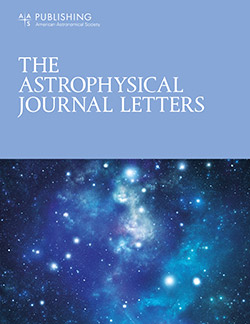Spatial Extent of Molecular Gas, Dust, and Stars in Massive Galaxies at z ∼ 2.2–2.5 Determined with ALMA and JWST
IF 8.8
1区 物理与天体物理
Q1 ASTRONOMY & ASTROPHYSICS
引用次数: 0
Abstract
Abstract We present the results of 0.″6-resolution observations of CO J = 3 − 2 line emission in 10 massive star-forming galaxies at z ∼ 2.2–2.5 with the Atacama Large Millimeter/submillimeter Array (ALMA). We compare the spatial extent of molecular gas with those of dust and stars, traced by the 870 and 4.4 μ m continuum emissions, respectively. The average effective radius of the CO emission is 1.75 ± 0.34 kpc, which is about 60% larger than that of the 870 μ m emission and is comparable with that of the 4.4 μ m emission. Utilizing the best-fit parametric models, we derive the radial gradients of the specific star formation rate (sSFR), gas depletion timescale, and gas-mass fraction within the observed galaxies. We find a more intense star formation activity with a higher sSFR and a shorter depletion timescale in the inner region than in the outer region. The central starburst may be the primary process for massive galaxies to build up a core. Furthermore, the gas-mass fraction is high, independent of the galactocentric radius in the observed galaxies, suggesting that the galaxies have not begun to quench star formation. Given the shorter gas depletion timescale in the center compared to the outer region, quenching is expected to occur in the center first and then propagate outward. We may be witnessing the observed galaxies in the formation phase of a core prior to the forthcoming phase of star formation propagating outward.用ALMA和JWST测定z ~ 2.2-2.5大质量星系中分子气体、尘埃和恒星的空间范围
摘要给出了0。″利用阿塔卡马大型毫米/亚毫米阵列(ALMA)对10个大质量恒星形成星系z ~ 2.2-2.5波段CO J = 3−2线发射的6分辨率观测。我们比较了分子气体与尘埃和恒星的空间范围,分别由870 μ m和4.4 μ m连续辐射追踪。CO发射的平均有效半径为1.75±0.34 kpc,比870 μ m发射的平均有效半径大60%左右,与4.4 μ m发射的平均有效半径相当。利用最佳拟合参数模型,我们推导了观测星系内特定恒星形成率(sSFR)、气体耗尽时间尺度和气体质量分数的径向梯度。我们发现,与外部区域相比,内部区域具有更高的sSFR和更短的耗尽时间尺度,恒星形成活动更强烈。中心的星暴可能是大质量星系形成核心的主要过程。此外,在观测到的星系中,气体质量分数很高,与星系中心半径无关,这表明星系还没有开始淬灭恒星形成。考虑到中心的气体耗尽时间比外部区域短,预计淬火首先发生在中心,然后向外扩散。在即将到来的向外传播的恒星形成阶段之前,我们可能正在目睹观察到的星系在核心形成阶段的形成阶段。
本文章由计算机程序翻译,如有差异,请以英文原文为准。
求助全文
约1分钟内获得全文
求助全文
来源期刊

Astrophysical Journal Letters
ASTRONOMY & ASTROPHYSICS-
CiteScore
14.10
自引率
6.30%
发文量
513
审稿时长
2-3 weeks
期刊介绍:
The Astrophysical Journal Letters (ApJL) is widely regarded as the foremost journal for swiftly disseminating groundbreaking astronomical research. It focuses on concise reports that highlight pivotal advancements in the field of astrophysics. By prioritizing timeliness and the generation of immediate interest among researchers, ApJL showcases articles featuring novel discoveries and critical findings that have a profound effect on the scientific community. Moreover, ApJL ensures that published articles are comprehensive in their scope, presenting context that can be readily comprehensible to scientists who may not possess expertise in the specific disciplines covered.
 求助内容:
求助内容: 应助结果提醒方式:
应助结果提醒方式:


